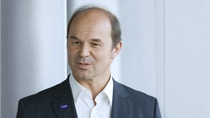Sustainability
Nanotechnology: The real work begins after the euphoria
A few years ago, the media mostly talked about the opportunities and benefits when reporting on nanotechnology. Then, the discussion shifted towards possible risks. By now, reporting on nanotechnology has quieted down. But the uncertainty in the industry and among consumers remains. And now? Dr. Martin Brudermüller, Vice Chairman of the Board of Executive Directors and Chief Technology Officer of BASF, is responsible for nanotechnology within the company.

1. Mr. Brudermüller, BASF has been using nanotechnology for many years now. Has it paid off?
Absolutely. Nanotechnology played a critical role in the development of several products we have successfully introduced in the market. These include the insulating foam Slentite®, the automotive clearcoat iGloss®, the concrete additive Master XSeed® and the UV filter Tinosorb® A2B. Nanotechnology is a very important technology for us which provides access to innovations with new properties and at the same time helps to conserve resources. Without nanotechnology, some products would not be in our portfolio today.
At the beginning – as with many other new technologies – there was a certain amount of excitement about nanotechnology and an expectation that new products with groundbreaking properties would quickly become available in the market. But after the first euphoria always the real work begins. That’s when you see what the new technology is capable of. Many years go by until products are ready to be introduced in the market and are qualified by the customer. This is a typical process for any new technologies and not specific to nanotechnology.
2. The safety of nanomaterials has always been an issue. What’s your view?
We only market products that are safe in the intended use, both for people and the environment. We take full responsibility for that.
Being able to make such a statement and have such strong conviction for nanomaterials is based on our excellent safety research. Our experts are internationally recognized. Their research contributes significantly to the sound assessment of products’ safety and compliance with legal regulations. In recent years, we have performed more than 240 toxicological and ecotoxicological studies and participated in more than 30 projects on the safety of nanomaterials. For example, in cooperation with the Federal Ministry for the Environment, Nature Conservation, Building and Nuclear Safety (BMUB) and the Federal Institute for Occupational Safety and Health (BAuA), possible long-term effects of nanoparticles in the lung were investigated in a worldwide unique long-term study. With the results that will be published at the beginning of the new year, we will gain many new insights than can be incorporated into a factual discussion about the safety of nanomaterials.
But we are not the only ones engaged in safety research. To date, the EU has invested almost €300 million in studies on the safety of nanomaterials. So far, there has been no case where the examined nanomaterials were determined toxic based solely on the size of the nanoparticles. Whether something is toxic depends primarily on the chemistry of the substance – and secondarily on the size of the particles.
3. Is it not too late to address the safety of new products shortly before or even after they are available on the market?
Of course, that would not be sufficient. This is why we prioritize safety from the early stages of our product research and examine the regulatory environment so that there are no toxicological or regulatory surprises at the end. We look at the entire lifecycle of a product. For example, it has been shown that plastics or building materials containing nanoparticles can be used just as safely as other plastics or building materials.
4. And yet, there is uncertainty among consumers and businesses when it comes to nanotechnology. How is BASF dealing with that?
I am not at all uncertain when it comes to the significance, benefits and safety of nanotechnology.
But not knowing exactly where things are heading and what the regulatory environment will look like in the future makes planning harder for all those involved in the value chain. This does not only apply to BASF but also to our customers and consumers. After all, they ask themselves: Should we sell or buy products with nanomaterials? Are these products safe? Are existing regulations sufficient and will they be valid long-term?
That is why we want politicians to have clear and appropriate regulations that prioritize safety, eliminate uncertainties and enable innovation. The basis for such regulations must be scientifically founded facts. Individual groups of substances, such as nanomaterials, should not be classified as dangerous from the outset independently of or even contrary to scientific findings. For this reason, we are politically involved.
But I am also convinced that we can only ensure greater clarity and thus decision-making authority if all interest groups are involved. That's why we engage early with our customers to address uncertainties and discuss what the joint future path for successfully using nanotechnology could be. Additionally, we have been in dialog with various representatives of environmental and consumer organizations for years, for example with our dialog forum ‘Nano’, to create mutual – and in some aspects common – understanding.
Together, we have come a long way towards establishing a political and societal environment in which the potential of nanotechnology can be safely used. I am confident that we will also manage the last part of the journey.